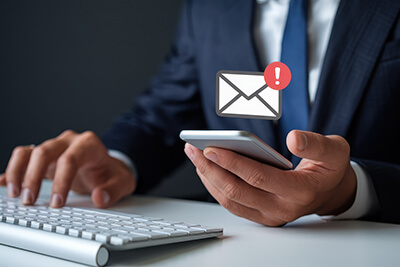Reaching your audience effectively is more complex than ever, with countless communication channels vying for attention. However, this complexity is a good thing because it allows you to target your specific audience more directly—as long as you narrow your approach correctly. That means you need to decide which option is best for your business needs.
Among the options to choose from, two of the most prominent are SMS (text) and email marketing. Both present unique advantages, but that doesn’t mean you should blindly use both. Knowing when to use each—or how to strategically combine them—can unlock powerful outreach that connects directly with your audience while achieving measurable business results.
Are you looking to drive instant engagement with concise updates? Or do you need a platform to deliver detailed messages with layered visuals and storytelling? Below, we’ll explore the strengths of text and email marketing, showcase their standout features, and help you assess which fits your business’s needs—or how they can work together for the ultimate marketing mix.
FOMO: Message Urgency and Engagement

The urgency of your message often dictates the channel you should use. For instance, texts excel at delivering time-sensitive or immediate content. A flash sale with only 24 hours to shop, an exclusive restock of a popular product, or a shipping deadline are all scenarios where text marketing shines. SMS enables rapid communication, offering bite-sized content and high open rates—often within minutes of delivery. It’s the perfect avenue for sparking quick conversions and nudging customers to take action fast.
Email, on the other hand, offers the space to explore more detailed narratives and visual content. Retailers sharing seasonal gift guides, food companies sending recipes, or businesses promoting blog posts can benefit from email’s flexibility. Imagery, multiple calls-to-action, and longer-form copy find their ideal home in email communications. Additionally, emails are cost effective for delivering information-rich materials without incurring the higher expenses associated with sending MMS messages.
Choosing between text and email for urgency is about matching the intent of your message. Are you prompting immediate action, or do you want to inspire thoughtful engagement with value-added content? The answer will guide your choice.
HMU: Customer Interaction and CTA Design
Your call-to-action (CTA) fundamentally shapes how you guide the recipient’s next steps. Text messages, with their simplicity and directness, excel in scenarios requiring immediate interaction. For example, prompting a customer to call your business is seamless within a text. SMS allows you to include direct click-to-call links within the message. This saves both time and effort, reducing friction between your audience segments and their decision to connect with you.
Emails, in contrast, are better suited for tasks that require more input or desktop navigation. Forms with multiple fields—such as those for tailored quotes, surveys, or sample requests—can overwhelm users when accessed via text on a small mobile screen. Lengthier forms or actions requiring considerable input feel more manageable on a desktop interface, making email an ideal delivery channel.
Understanding how your audience prefers to engage and aligning that with your CTA’s design ensures a smoother user experience across formats and helps grow your contact list. Consider the complexity of actions you’re asking for—and choose the marketing channel accordingly.
BFFs: Knowing Your Audience’s Lifestyle

Your audience’s lifestyle also plays a significant role in determining whether text or email marketing is more effective. If your target demographic tends to be constantly on the go, SMS marketing provides a way to meet them where they are. Parents balancing multiple schedules or professionals commuting daily may not have time to check emails often, but they’re likely glancing at text notifications throughout the day. With such immediacy, SMS ensures your message is received, regardless of how fast-paced their lives may be.
On the other hand, email better serves individuals with a more settled routine. If your audience frequently works from a computer or values leisurely reading, emails provide the opportunity for them to digest content without the urgency or brevity of a text. For industries catering to niches like remote professionals or hobbyists, email offers an effective channel to deliver thoughtfully paced, content-rich communication.
Considering who your audience is—and how they go about their day—can clarify where your marketing efforts will have the most significant impact.
WYA: Geographic Reach and Local Context
The geographic location of your audience also factors into whether text or email marketing is ideal. Texting costs can increase significantly when sending messages to recipients outside of your primary region, which might make SMS communication less cost effective for businesses targeting a global audience.
However, SMS can be an impactful tool for highly localized efforts. For example, reaching customers in a specific city to promote an in-store event or a deadline for local delivery aligns perfectly with SMS’s immediacy and concise format. Targeting only those within a defined radius maximizes effectiveness while minimizing unnecessary expenses.
For a broader, more widespread audience—especially those spread across multiple regions or markets—email campaigns are a better option. They allow for scalability and rich visual promotion without the financial considerations tied to cross-border communication. The content remains accessible for recipients worldwide without adding extra costs to your marketing budget.
TLDR: Combining Text and Email Marketing for Maximum Effect

While there are clear distinctions between SMS and email marketing that will lead many businesses to choose one option over the other, the best strategy often combines both to capitalize on the strengths of each channel. Using email for in-depth storytelling and SMS for timely reminders builds a cohesive experience across touchpoints. For example, a retailer showcasing a new product can send a detailed email with product descriptions, customer stories, and imagery. Later in the week, a reminder SMS can nudge subscribers about limited stock or special discounts.
The interplay doesn’t end with complementing messages, either. Consistent branding, cross-promotion, and personalization across channels can amplify your impact. The same messaging tone used for both SMS and email conveys reliability while making every interaction feel cohesive. Harnessing customer data to address personalization boosts customer engagement, illustrating a tailored approach that values their time and preferences.
Achieving balance between the mediums requires an understanding of your audience’s behavior, priorities, and context. However, the execution of this tactic is easier said than done, which is why it’s smart to seek outside help. Logical Position can help you build customer awareness and loyalty, drive lead generation, and boost e-commerce sales through our fully managed, targeted email marketing services. Seize your brand’s full potential with our customized marketing packages.





